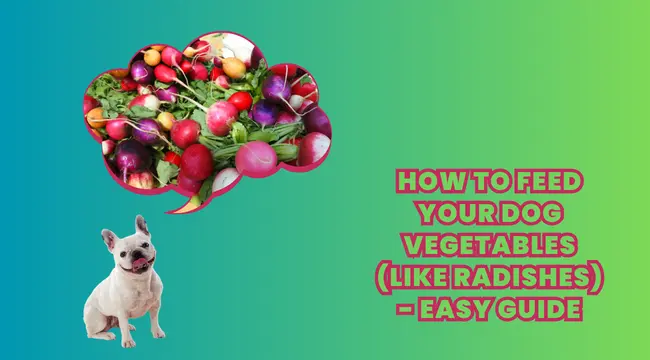
Incorporating vegetables into your dog’s diet is a fantastic way to boost their nutrient intake and provide variety in their meals. Vegetables like radishes can offer health benefits including added fiber, vitamins, and minerals. However, it’s important to introduce any new food item properly to ensure it’s safe and enjoyable for your pet. If you’re wondering whether radishes are suitable for your dog, discover more with this detailed guide on can your dog eat radishes.
Benefits of Feeding Vegetables to Dogs
Vegetables are a great addition to your dog’s diet for several reasons:
Rich in Essential Nutrients
Vegetables like radishes are packed with vitamins and minerals that play critical roles in the health and well-being of dogs. They provide essential nutrients that are often scarce in processed dog foods, such as Vitamin C for immune function, potassium for muscle health, and antioxidants for cellular health. These nutrients help in the maintenance of numerous body functions, from enhancing muscle strength to improving nerve transmission and fluid balance within the body.
Low in Calories
Vegetables are inherently low in calories and fats, making them an excellent choice for maintaining a healthy weight in dogs. Incorporating vegetables into your dog’s diet can help prevent obesity, which is linked to various health issues including diabetes, joint stress, and cardiovascular problems. Additionally, the high fiber content in vegetables like radishes can promote satiety—a feeling of fullness—which can help curb overeating.
Natural Hydration
Vegetables are not only nutritious but also a great source of hydration, which is particularly important for your dog’s health. High water content in vegetables like cucumbers, lettuce, and radishes helps maintain adequate hydration levels, which is crucial for nearly all bodily functions. Proper hydration aids in digestion, helps regulate body temperature, and facilitates the transport of nutrients and elimination of waste. During hotter months, adding these water-rich vegetables to your dog’s diet can be especially beneficial to prevent dehydration. The added moisture in these foods can also be advantageous for dogs that are less inclined to drink adequate amounts of water throughout the day.
Promotes Digestive Health
Incorporating vegetables like radishes in your dog’s diet can promote digestive health due to their fiber content. Dietary fiber plays a crucial role in aiding digestion by helping to regulate the digestive system and ensure smooth bowel movements. Fiber can also act as a prebiotic, feeding the good bacteria in the gut, which is essential for a healthy digestive tract. Moreover, it helps to bulk up the stool and can aid in alleviating the symptoms of diarrhea and constipation. By maintaining a healthy digestive system, fiber helps enhance the overall nutrient absorption and health of your dog, making them feel more comfortable and energetic.
Boosts Immune System
Vegetables are rich in antioxidants and essential nutrients that play a vital role in enhancing your dog’s immune system. Antioxidants such as Vitamin C and beta-carotene help protect the body’s cells from damage caused by free radicals, which are unstable molecules that can harm cells and lead to chronic diseases. These nutrients support the body’s natural defenses against environmental pollutants, stress, and infections. Regular inclusion of antioxidant-rich vegetables like radishes in your dog’s diet can help boost their immunity, making them better equipped to fight off illnesses and recover more quickly when they do get sick. This overall enhancement of the immune system contributes to a longer, healthier life for your pet.
Introducing Vegetables to Your Dog’s Diet
Transitioning your dog to a diet that includes vegetables should be done gradually to ensure it is well tolerated and to prevent digestive upset.
Start with Small Amounts
Introduce vegetables into your dog’s diet gradually. Starting with small amounts allows your dog to adjust to the new foods without overwhelming their digestive system, and lets you monitor their reaction to each new vegetable.
Cook Vegetables to Enhance Digestibility
Raw vegetables can be tough for dogs to break down, so cooking them lightly, such as steaming, can make them easier to digest. This process helps in preserving the nutrients while making them more accessible for digestion.
Mix with Their Regular Food
Blending vegetables with foods that your dog already enjoys can help ease the transition. This method helps them get used to the new flavors and textures mixed with familiar tastes.
Consult Your Veterinarian
Always consult with a veterinarian before introducing significant dietary changes. They can provide guidance based on your dog’s specific health needs and dietary requirements.
Monitor Your Dog’s Reaction
Observe your dog for any signs of digestive issues or allergies when introducing new vegetables. If you notice any negative reactions, adjust their diet accordingly and consult your veterinarian.
How to Prepare Radishes for Your Dog
Radishes can be a crunchy, nutritious treat for dogs, but they should be prepared properly to ensure they are safe and enjoyable for your pet to eat.
- Wash and Peel
Always start by thoroughly washing radishes to remove any pesticides or dirt. Peeling them is recommended to reduce the risk of digestive issues, as the skin can be tough and difficult for dogs to digest.
- Cut into Small Pieces
Chopping radishes into small, bite-sized pieces is crucial to prevent choking hazards. This also makes it easier for your dog to chew and digest them properly.
- Serve in Moderation
Radishes should be introduced as a treat, not a primary food source. Serving them in moderation ensures that your dog gets the benefits without the risk of gastrointestinal upset.
- Consider Your Dog’s Size and Breed
Adjust the size and quantity of radish pieces according to the size and breed of your dog. Smaller dogs require smaller pieces to ensure they can safely chew and swallow them.
- Observe and Adjust
After serving radishes to your dog, observe how they react to this new addition to their diet. Some dogs might find radishes too spicy or may have difficulty digesting them. If this is the case, it’s best to try other, more suitable vegetables.

Additional Tips for Feeding Your Dog Vegetables
Here are some additional tips to ensure that feeding your dog vegetables like radishes is a success:
- Variety is Key: Introduce a variety of vegetables to provide a range of nutrients.
- Avoid Seasonings: Do not add salt, onion, garlic, or other seasonings that can be harmful to dogs.
- Balance the Diet: Vegetables should complement, not replace, a balanced diet that meets all of your dog’s nutritional needs.
Conclusion
Feeding your dog vegetables like radishes can be a healthy supplement to their diet, providing essential nutrients and variety. It’s important to introduce any new food slowly and with care to ensure that it is well tolerated and beneficial for your dog. Always consult with your veterinarian before making significant changes to your dog’s diet, and monitor your pet’s reaction to new foods. With the right approach, vegetables can enhance your dog’s health, happiness, and longevity.



